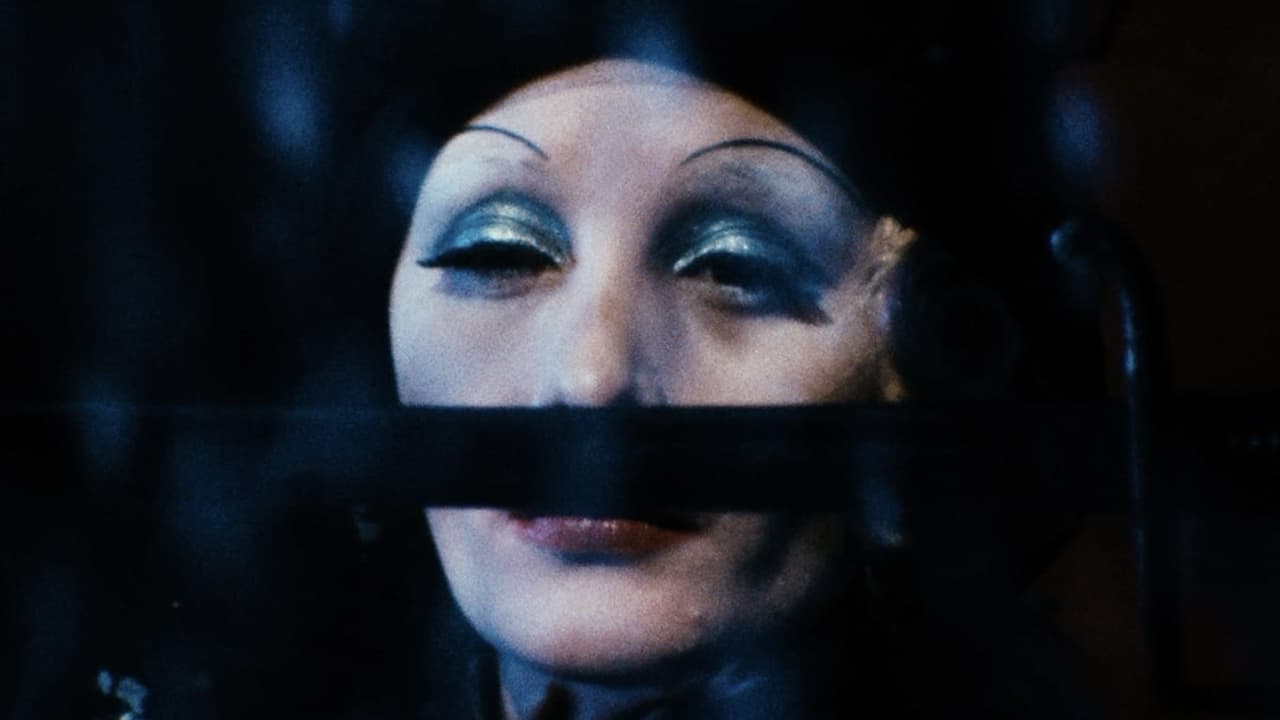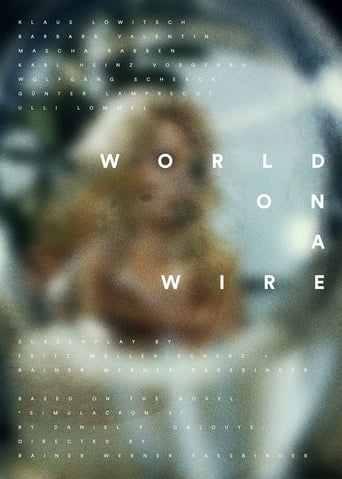Inclubabu
Plot so thin, it passes unnoticed.
Beystiman
It's fun, it's light, [but] it has a hard time when its tries to get heavy.
CrawlerChunky
In truth, there is barely enough story here to make a film.
InformationRap
This is one of the few movies I've ever seen where the whole audience broke into spontaneous, loud applause a third of the way in.
tieman64
"The more powerful the class, the more it claims not to exist, and its power is employed above all to enforce this claim. It is modest only on this one point, however, because this officially nonexistent bureaucracy simultaneously attributes the crowning achievements of history to its own infallible leadership. Though its existence is everywhere in evidence, the bureaucracy must be invisible as a class. As a result, all social life becomes insane." ― Guy DebordWerner Fassbinder's "World on a Wire" was first released on German television in 1973. Forgotten for decades, it reappeared in 2010 with new prints and a theatrical release, at which point it was quickly embraced as one of cinema's hidden milestones.Pre-dating "The Matrix", "Blade Runner", "Inception", "Existenz", "Dark City", "Ghost in the Shell", "Paprika", "Strange Days", "Star Trek" ("Ship in a Bottle", "Projections") and many other similar works, "Wire" stars Klaus Lowitsch as Fred Stiller. Stiller's working with the Institute for Cybernetics and Future Science, who are busy creating an artificial world populated by thousands of sophisticated A.I. "identity units". The film was based on "Simulacron 3", a 1964 novel by Daniel Galouye. Philip K. Dick's "The Simulacra" was published the same year."Wire's" first half plays with now familiar questions of phenomenology (what constitutes experience, perception and consciousness?), epistemology (what is knowledge and how is it acquired?) and ontology (what constitutes the self, existence and reality?). Here Stiller realises that he is in fact a computer simulation of the Real Fred Stiller. This baffles poor Fred, as he has also recently created a computer simulation of "himself". The film thus offers a series of nested realities, simulations boxed within simulations boxed within simulations. When the "identity units" recognise that they are "not authentic", they begin to view others as phony automatons, have little existential crises and slip into depression. Some exhibit the existence denial of Cotard's Syndrome ("I think that I don't exist!"). Others resort to suicide.Like Fassbinder's "identity units", humans are themselves "machines who are not aware that they are machines". Each of us is mechanistically programmed by an unbroken causal chain, and what we "see" is itself a mental simulation or representational content. The claims of "naive realists" (the belief that senses provide direct awareness) are similarly false. Our phenomenal life unfolds in a world-model and we are always blind to the mediums through which "things" are transmuted en-route to us. Thinkers like Hume, Schopenhauer, Locke, Sartre, Daniel Dennet and many other modern neuroscientists have also dethroned the notion of the Sovereign Self. For them, selfhood only exists at the level of false appearances. It is an accidental byproduct of processes which misrepresent "themselves" for "itself", and even consciousness only arises "after the fact", always dependent on objects which the subject is inadvertently constructed in relation to. Other philosophers are equally, or overly, droll. "The brute fact is that there is nothing behind the face," Thomas Metzinger would say. "There's no one there." And Erwin Schrodinger: "To learn that the personality of a human being cannot really be found in the interior of a human body is so amazing that it meets with doubts and hesitation, we are very loath to admit it." But Fassbinder, a neo-Marxist, has always been more interested in the political. Like many of his pictures, "Wire" thus paints late capitalism as a superstructure which co-opts everything it touches. This is a giant control society, a kind of giddily embraced techno-totalitarianism in which everything is under surveillance, personalities are managed and created, everyone is an automaton lost in their own private cyberspational urgencies, capitalism has fully colonised human consciousness and machines simulate reality whilst people simulate "individuality" and "authenticity". "You're nothing more than the image others have made of you!" characters say. More than this, "Wire" portrays "reality" as a collective psychosis in which all social energy is sucked into a vortex of labour and simulated productivity. The simulations made by The Institute, we later learn, are themselves intended for the prediction of future market trends, the "identity units" (and the whole world itself) literally created for the purpose of monitoring buying, selling and consumption. More eerily, the simulations within the simulations seem designed to investigate how people react to certain forms of control; a dry run for a total conversion which will soon occur, or may already have. Regardless, with the help of the "identity units", Germany's economy can be meticulously pre-planned and engineered. This kind of Big Data Mining is already occurring – the superstore Target famously mailed pregnancy kits to a teenage girl, successfully predicting her pregnancy before the girl, her family, lover or father knew she was pregnant – computerised pattern detectors already surmising from and shaping behaviour. Elsewhere Fassbinder shows, not just the political cost of distraction, but how distraction and solipsism are desired by those on every level of society. The Real Fred Stiller programs himself as a suave ladies man, humans love the idealisations sold to them by their digital echo chambers and the Masters rake in the cash whilst everyone remains oblivious. Meanwhile, those pesky "identity units" who wreak the party are "deleted" or "suicided" with the flip of a switch. The film's overriding metaphor (Zeno's Paradox), points to a world in which everything moves but no distance is travelled and no progress is made.Aesthetically, "Wire" gives us mirrored surfaces, alienating spaces and a style which mixes noir, SF and retro-futurism. Its signature song is Wagner's "Tristan and Isolde", used as an ironic commentary on the idealisations of Fassbinder's characters, but perhaps chosen because it was itself inspired by Schopenhauer's "The World as Will and Representation". The film ends with a playboy and playgirl in a box, spinning in false assumptions.8.5/10 - Masterpiece but overlong.
john-2448
Part 1 of Fassbinder's sci-fi foray, World on a Wire is quite good. I always like his direct, theatrical style. He opens with some references to 2001 -- white plastic futuristic decor, space opera music -- to set the tone. Then there's a whole lot of Alphaville -- hosts of blank expressions held artificially long -- and early Godard. And sure enough Eddie Constantine even has a small role near the end of Part 2.It's a very Matrixy premise, from way back in 1973, of a world of people, termed identity units, created artificially in a supercomputer as an experimental control group, with the goal of predicting future human behavior and learning what to avoid/promote. There is an element of Big Gov't social engineering, and then companies move in to try to learn future demand (Big Steel is the baddie here, which is a little dated). In other words, it's just like today's world, with all of us trying to become identity units for Google to track ... or somesuch. The Thirteenth Floor (1999) is also based on the same novel "Simulacron 3" by Daniel F. Galouye.Fassbinder uses lots of mirror shots to disorient and question the reality of identity and the nature of reality. With the camera often tracking over to mirrors, or starting with mirror images which only become apparent when the camera tracks a person's movement away from and out of a mirror. The room housing the supercomputer has a couple of fully mirrored walls, which gives it a sleek futuristic look, and acts as a visual metaphor for the layers of reality/unreality.I especially liked seeing Fassbinder regulars pop up. El Hedi ben Salem plays a bodyguard/security agent; Barbara Valentin a sexy secretary/ corporate spy. This was originally done for German television, and Fassbinder uses some of these actors for his later TV opus Berlin Alexanderplatz. There is a weird sequence in World on a Wire, where Gottfried John's character takes over Gunter Lamprecht's body (which in BA terms is Reinhold taking over Franz Biberkopf, which has eerie resonance).I was a bit underwhelmed with the extra: Fassbinder's World On A Wire: Looking Ahead To Today, but it did shed light on the casting. The fearless 27 year old Fassbinder used many older ex-stars for the project, an interesting decision to go retro to obtain a slightly futuristic feel -- similar to Godard's choice of Eddie Constantine in Alphaville. Fassbinder wants something to be a little off and odd about the characters, and so he uses past-their-prime actors, has them stare blankly unnaturally long, and dresses them up in costumes, distinctly retro, which they wear like costumes. This style creates a unique look and feel to the whole proceedings, distinctly off and slightly phony, accordant with the artificial reality theme.The second half of World on a Wire is a little weaker. Part 2 becomes a paranoid thriller, as Fassbinder mostly focuses on the psychological aspects and the chase/hunt for the man who knows too much about the different levels of reality. And actually that's a joke Fassbinder tosses in. The focus is on a lone man wrongfully accused and caught up in a vast conspiracy. Less than one minute after I said to myself, Gee, this is becoming rather Hitchcockian, Fassbinder has a character refer to another's death by saying, "poor Franz Holm, a man who knew too much." Wink.Part 2 is similar to such political/corporate conspiracy films as Parallax View, but now I see that Wire came out the year before Parallax. And Soylent Green came out just a few months earlier. Interesting. Altogether World on a Wire is nearly 3' 20", and it probably could have used a bit of trimming and tightening in the second half. But this is really an interesting addition to the Fassbinder legacy. Quite a treat for Fassbinder fans.
similacron
During my teens or should I say prime time I was "eating up" all kinds of SF novels every day of the week. It was in the Sixties and Seventies when TV was not such a important leisure time killer like today, one night in the mid seventies I watched the movie on TV I think it was ARD and I was stunned. I was impressed in a way that I can almost remember each scene even today.Nowadays I observe my kids playing the SIMS or something like that and I think we are close to what that Fassbender Movie expressed. I also would highly appreciate if I could buy this movie on a DVD. But in vain I tried almost everything to get a hint where. The movie MATRIX cannot touch by far the quality and the state of art of this movie. And by the way by now we do not have a glue if we were a superior reality or just one of a couple simulation models. Probably after our death we definitely will know...
Absinth
In these days of ultra-fast processors and the Internet, coming up with a movie like "The Matrix" may seem merely the next step from coining the term 'cyberspace', but do you remember what computers were like in 1974? Right. To come up with the notion of virtual reality back then is truly an amazing feat of the imagination. Fassbinder's movie, of course, has none of the massive gunslinging and pyrotechnics, and a lot of 'artsy' elements instead, but the atmosphere it creates is intense and poses the question how we can know what is real in a dark and gripping manner, making this a chiller and a thriller for the mind. It also takes it up a notch on more recent VR stories: if you get out of one cyberspace, can you be sure you didn't just emerge into another level of virtual reality?

